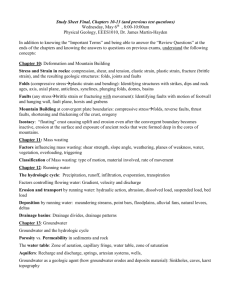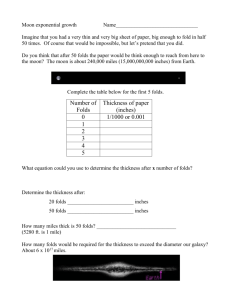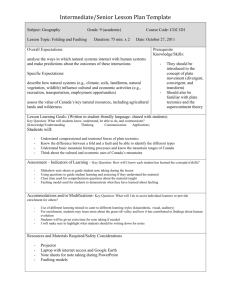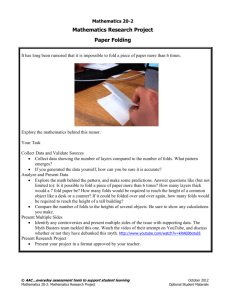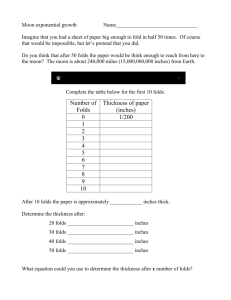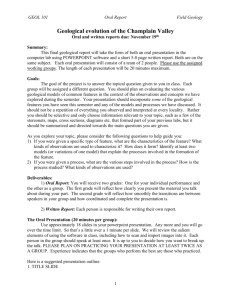mapping polyphase regional structures helps
advertisement
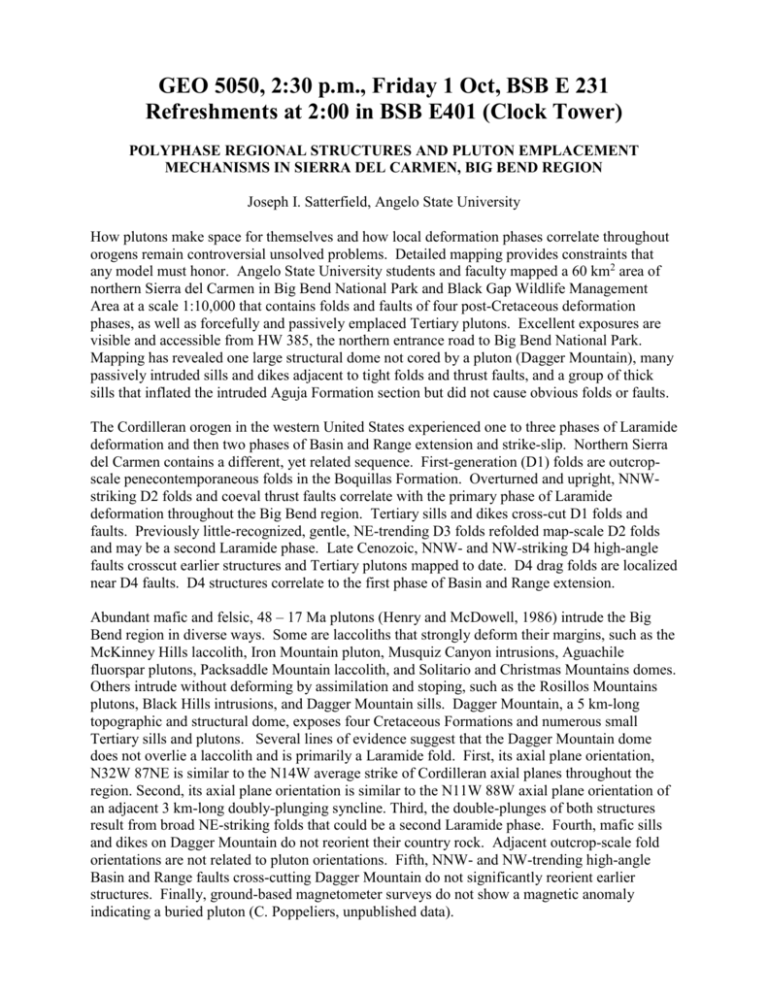
GEO 5050, 2:30 p.m., Friday 1 Oct, BSB E 231 Refreshments at 2:00 in BSB E401 (Clock Tower) POLYPHASE REGIONAL STRUCTURES AND PLUTON EMPLACEMENT MECHANISMS IN SIERRA DEL CARMEN, BIG BEND REGION Joseph I. Satterfield, Angelo State University How plutons make space for themselves and how local deformation phases correlate throughout orogens remain controversial unsolved problems. Detailed mapping provides constraints that any model must honor. Angelo State University students and faculty mapped a 60 km2 area of northern Sierra del Carmen in Big Bend National Park and Black Gap Wildlife Management Area at a scale 1:10,000 that contains folds and faults of four post-Cretaceous deformation phases, as well as forcefully and passively emplaced Tertiary plutons. Excellent exposures are visible and accessible from HW 385, the northern entrance road to Big Bend National Park. Mapping has revealed one large structural dome not cored by a pluton (Dagger Mountain), many passively intruded sills and dikes adjacent to tight folds and thrust faults, and a group of thick sills that inflated the intruded Aguja Formation section but did not cause obvious folds or faults. The Cordilleran orogen in the western United States experienced one to three phases of Laramide deformation and then two phases of Basin and Range extension and strike-slip. Northern Sierra del Carmen contains a different, yet related sequence. First-generation (D1) folds are outcropscale penecontemporaneous folds in the Boquillas Formation. Overturned and upright, NNWstriking D2 folds and coeval thrust faults correlate with the primary phase of Laramide deformation throughout the Big Bend region. Tertiary sills and dikes cross-cut D1 folds and faults. Previously little-recognized, gentle, NE-trending D3 folds refolded map-scale D2 folds and may be a second Laramide phase. Late Cenozoic, NNW- and NW-striking D4 high-angle faults crosscut earlier structures and Tertiary plutons mapped to date. D4 drag folds are localized near D4 faults. D4 structures correlate to the first phase of Basin and Range extension. Abundant mafic and felsic, 48 – 17 Ma plutons (Henry and McDowell, 1986) intrude the Big Bend region in diverse ways. Some are laccoliths that strongly deform their margins, such as the McKinney Hills laccolith, Iron Mountain pluton, Musquiz Canyon intrusions, Aguachile fluorspar plutons, Packsaddle Mountain laccolith, and Solitario and Christmas Mountains domes. Others intrude without deforming by assimilation and stoping, such as the Rosillos Mountains plutons, Black Hills intrusions, and Dagger Mountain sills. Dagger Mountain, a 5 km-long topographic and structural dome, exposes four Cretaceous Formations and numerous small Tertiary sills and plutons. Several lines of evidence suggest that the Dagger Mountain dome does not overlie a laccolith and is primarily a Laramide fold. First, its axial plane orientation, N32W 87NE is similar to the N14W average strike of Cordilleran axial planes throughout the region. Second, its axial plane orientation is similar to the N11W 88W axial plane orientation of an adjacent 3 km-long doubly-plunging syncline. Third, the double-plunges of both structures result from broad NE-striking folds that could be a second Laramide phase. Fourth, mafic sills and dikes on Dagger Mountain do not reorient their country rock. Adjacent outcrop-scale fold orientations are not related to pluton orientations. Fifth, NNW- and NW-trending high-angle Basin and Range faults cross-cutting Dagger Mountain do not significantly reorient earlier structures. Finally, ground-based magnetometer surveys do not show a magnetic anomaly indicating a buried pluton (C. Poppeliers, unpublished data).

